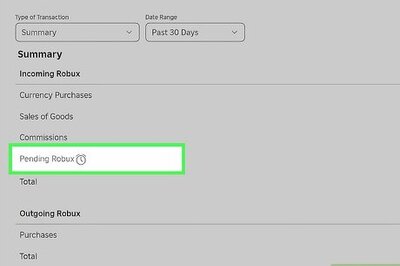
views
Using Baking Soda and Oil
Combine 1 part baking soda with 1 part oil. You can use any type of oil, like coconut or olive oil. Mix together equal parts of the oil and baking soda in a small bowl until they form a paste. The baking soda will act as an exfoliant to scrub off the glue. Other oil options include canola, vegetable, or sunflower oil. How much you mix up depends on the size of the glue spot. For glue left by a label on 1 plastic jar, for example, 1 tablespoon (15 ml) of baking soda and 1 tablespoon (15 ml) of oil should work. What Type of Oil to Use If you want your plastic to smell nice, mix a few drops of essential oil into your mixture, along with the cooking oil. Choose one like peppermint, lavender, or lemon. If you want the cheapest option, use vegetable oil. If the glue is really caked on, opt for coconut oil. It has more fat than olive oil, which is better for dissolving stubborn glue.
Rub the mixture into the area that has glue on it. Use your hands to apply the baking soda and oil, making sure to saturate all of the glue by rubbing in small circles. Add enough of the mixture so that the sticky spot is completely covered. If you have sensitive skin, you may want to wear gloves to do this as baking soda can dry out your hands. You can also use a dry cloth instead of your hands to rub in the mixture.
Let the mixture sit on the jar for 30 minutes. This allows the baking soda and oil to soften the glue so it won’t be as tough to remove. The longer you leave the mixture on, the more easily the glue will come off. Set a kitchen timer or use the clock app on your phone to keep track of the time.
Scrub off the glue with a scouring pad. If you have a standard kitchen sponge, use the more abrasive side. You need something rougher to pull up the glue residue. Continue rubbing vigorously until all of the glue is removed. For a little extra scrubbing power, you can use steel wool instead of a scouring pad. If the glue isn’t coming off, apply more baking soda and oil, then let it sit for another 30 minutes before trying to remove it again.
Wash the plastic with soap and warm water. This will get rid of any leftover tacky residue or oil. Wipe down the plastic with soap using a damp cloth, then rinse it until it’s no longer sticky or greasy. Dish soap will work well because it’s designed to cut through grease. Dry off the plastic with a clean cloth or let it air dry once you’ve rinsed it thoroughly.
Removing Glue with Other Household Products
Opt for a plastic scraper if the glue is already soft. For glue that isn’t completely hardened, or if you’ve already softened it with a liquid or oil mixture, use a plastic scraper to lift off the remaining residue. Be careful not to scratch the plastic as you gently wedge the scraper underneath the glue to remove it. Options for scrapers include a plastic knife or the edge of an old credit card that you no longer use. Avoid using a glass scraper or anything metal, like a razor blade, because it could damage the plastic.
Soak larger spots in vinegar to dissolve the glue. If you don’t want to endlessly scrub a bigger sticky area, douse a cloth or paper towel in vinegar and lay it over the glue. Leave it on for 15 to 30 minutes, then wipe off the now-loosened residue. To remove the vinegar smell, wash the plastic with soap and warm water afterwards. An alternative is to place the plastic in a bowl filled with vinegar to let it soak instead of using a cloth.
Try alcohol as a chemical-free solution for hard-to-remove glue. Douse a cotton ball in the liquid, then apply it to the glue. The residue should pull up as you scrub the spot. Continue rubbing it until all of the glue is removed, re-applying liquid as needed. You can use rubbing alcohol, nail polish remover, or vodka. To remove super glue with alcohol, let the liquid sit on the glue for 15 to 30 minutes to dissolve it before trying to scrub it off. If you’re using nail polish remover, make sure you’re using one that’s non-acetone. It’s gentler and safer for your skin.
Rub in mayonnaise or peanut butter if your plastic isn’t porous. Since both of these foods are primarily fats, they contain a lot of oil, which can seep into porous plastic, like reusable containers, and stain them. For sturdier plastics, coat the glue spot with a thick layer of mayonnaise or peanut butter, then let it sit for 30 minutes before removing it. How to Tell If Plastic Is Porous If you aren’t sure whether your plastic is porous, test a small spot. Apply a dab of either mayonnaise or peanut butter and wait half an hour. If you notice a stain, try a different method for getting rid of the glue.
Use a rubber eraser if there’s only a thin layer of glue. For example, if you’ve already removed a label, and there’s just a tiny bit of residue remaining on the plastic, rub an eraser over it. You’ll have to apply firm pressure so that the eraser rips up the glue. You can use either the small eraser on the end of a pencil or a larger rubber eraser.
Apply a store-bought cleaner if you have tough spots. Products specifically for removing glue, like Goo Gone or WD-40, are highly effective at getting rid of sticky stuff on plastic. Follow the directions on the package to make sure you’re using it safely and properly. Most cleaners require you to apply the product to the glue, wait for it to set, then remove it with a damp cloth. You can buy these cleaners at a hardware store or from an online retailer.



















Comments
0 comment